Energy Analysis Techniques Module: Energy Saving Measures Report
VerifiedAdded on 2022/10/11
|16
|3427
|11
Report
AI Summary
This report provides a comprehensive overview of De Montfort University's efforts to control energy consumption, detailing the implemented energy-saving measures and the challenges faced. The university has undertaken several initiatives, including yearly energy audits, the installation of automatic lighting sensors, and the encouragement of switching off lights and electronics when not in use. Key projects include voltage optimization, boiler load management systems, and the use of LED lighting, with significant investments in the Queen Elizabeth II Diamond Jubilee leisure center. The report also highlights the advantages, such as the formation of energy-saving clubs and increased awareness among students, and the challenges, including data limitations and inadequate funding for research. The university has set ambitious goals to reduce carbon emissions and has implemented various strategies such as LED lighting, variable speed drives, and energy audits to achieve them.
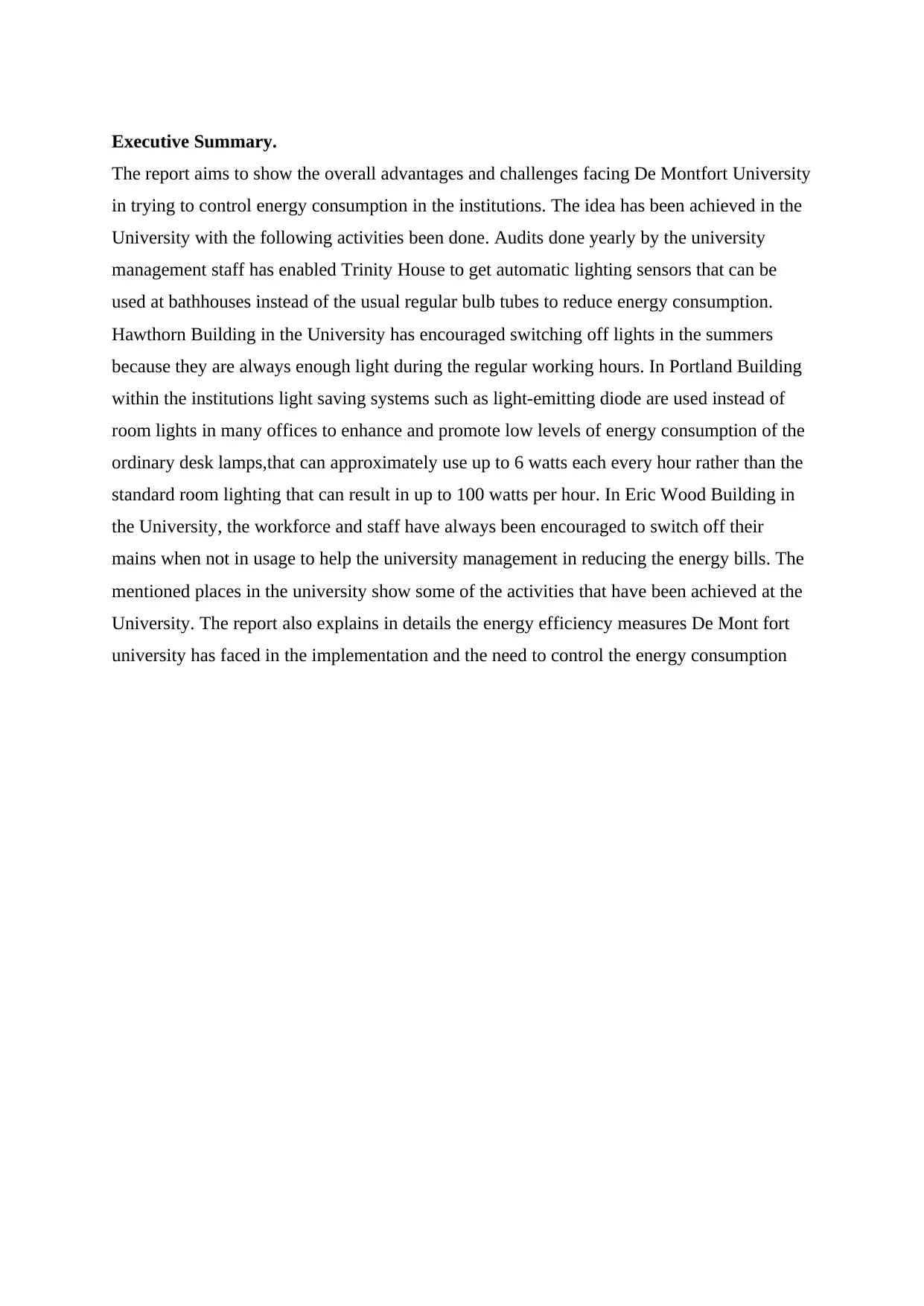
Executive Summary.
The report aims to show the overall advantages and challenges facing De Montfort University
in trying to control energy consumption in the institutions. The idea has been achieved in the
University with the following activities been done. Audits done yearly by the university
management staff has enabled Trinity House to get automatic lighting sensors that can be
used at bathhouses instead of the usual regular bulb tubes to reduce energy consumption.
Hawthorn Building in the University has encouraged switching off lights in the summers
because they are always enough light during the regular working hours. In Portland Building
within the institutions light saving systems such as light-emitting diode are used instead of
room lights in many offices to enhance and promote low levels of energy consumption of the
ordinary desk lamps,that can approximately use up to 6 watts each every hour rather than the
standard room lighting that can result in up to 100 watts per hour. In Eric Wood Building in
the University, the workforce and staff have always been encouraged to switch off their
mains when not in usage to help the university management in reducing the energy bills. The
mentioned places in the university show some of the activities that have been achieved at the
University. The report also explains in details the energy efficiency measures De Mont fort
university has faced in the implementation and the need to control the energy consumption
The report aims to show the overall advantages and challenges facing De Montfort University
in trying to control energy consumption in the institutions. The idea has been achieved in the
University with the following activities been done. Audits done yearly by the university
management staff has enabled Trinity House to get automatic lighting sensors that can be
used at bathhouses instead of the usual regular bulb tubes to reduce energy consumption.
Hawthorn Building in the University has encouraged switching off lights in the summers
because they are always enough light during the regular working hours. In Portland Building
within the institutions light saving systems such as light-emitting diode are used instead of
room lights in many offices to enhance and promote low levels of energy consumption of the
ordinary desk lamps,that can approximately use up to 6 watts each every hour rather than the
standard room lighting that can result in up to 100 watts per hour. In Eric Wood Building in
the University, the workforce and staff have always been encouraged to switch off their
mains when not in usage to help the university management in reducing the energy bills. The
mentioned places in the university show some of the activities that have been achieved at the
University. The report also explains in details the energy efficiency measures De Mont fort
university has faced in the implementation and the need to control the energy consumption
Paraphrase This Document
Need a fresh take? Get an instant paraphrase of this document with our AI Paraphraser
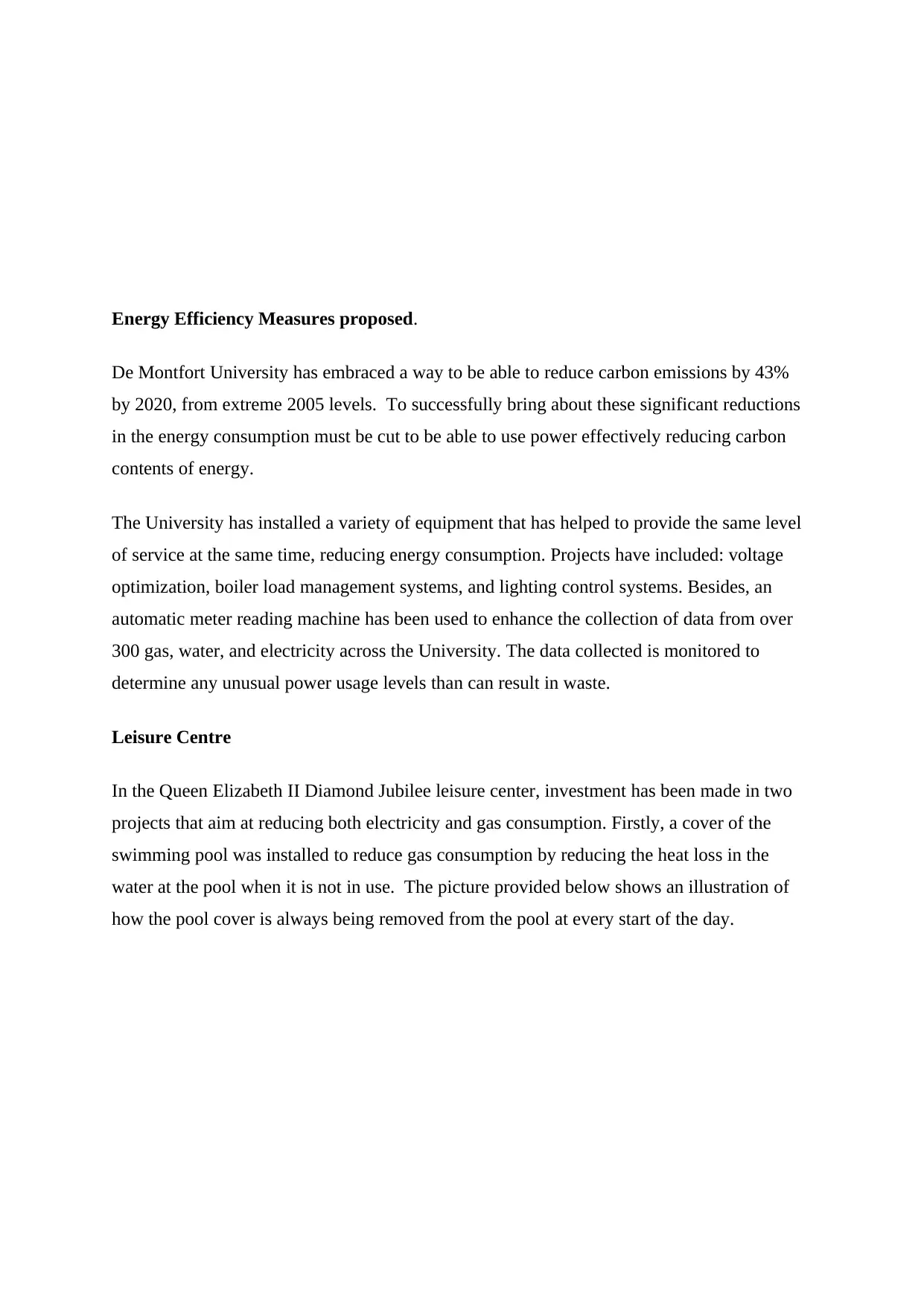
Energy Efficiency Measures proposed.
De Montfort University has embraced a way to be able to reduce carbon emissions by 43%
by 2020, from extreme 2005 levels. To successfully bring about these significant reductions
in the energy consumption must be cut to be able to use power effectively reducing carbon
contents of energy.
The University has installed a variety of equipment that has helped to provide the same level
of service at the same time, reducing energy consumption. Projects have included: voltage
optimization, boiler load management systems, and lighting control systems. Besides, an
automatic meter reading machine has been used to enhance the collection of data from over
300 gas, water, and electricity across the University. The data collected is monitored to
determine any unusual power usage levels than can result in waste.
Leisure Centre
In the Queen Elizabeth II Diamond Jubilee leisure center, investment has been made in two
projects that aim at reducing both electricity and gas consumption. Firstly, a cover of the
swimming pool was installed to reduce gas consumption by reducing the heat loss in the
water at the pool when it is not in use. The picture provided below shows an illustration of
how the pool cover is always being removed from the pool at every start of the day.
De Montfort University has embraced a way to be able to reduce carbon emissions by 43%
by 2020, from extreme 2005 levels. To successfully bring about these significant reductions
in the energy consumption must be cut to be able to use power effectively reducing carbon
contents of energy.
The University has installed a variety of equipment that has helped to provide the same level
of service at the same time, reducing energy consumption. Projects have included: voltage
optimization, boiler load management systems, and lighting control systems. Besides, an
automatic meter reading machine has been used to enhance the collection of data from over
300 gas, water, and electricity across the University. The data collected is monitored to
determine any unusual power usage levels than can result in waste.
Leisure Centre
In the Queen Elizabeth II Diamond Jubilee leisure center, investment has been made in two
projects that aim at reducing both electricity and gas consumption. Firstly, a cover of the
swimming pool was installed to reduce gas consumption by reducing the heat loss in the
water at the pool when it is not in use. The picture provided below shows an illustration of
how the pool cover is always being removed from the pool at every start of the day.
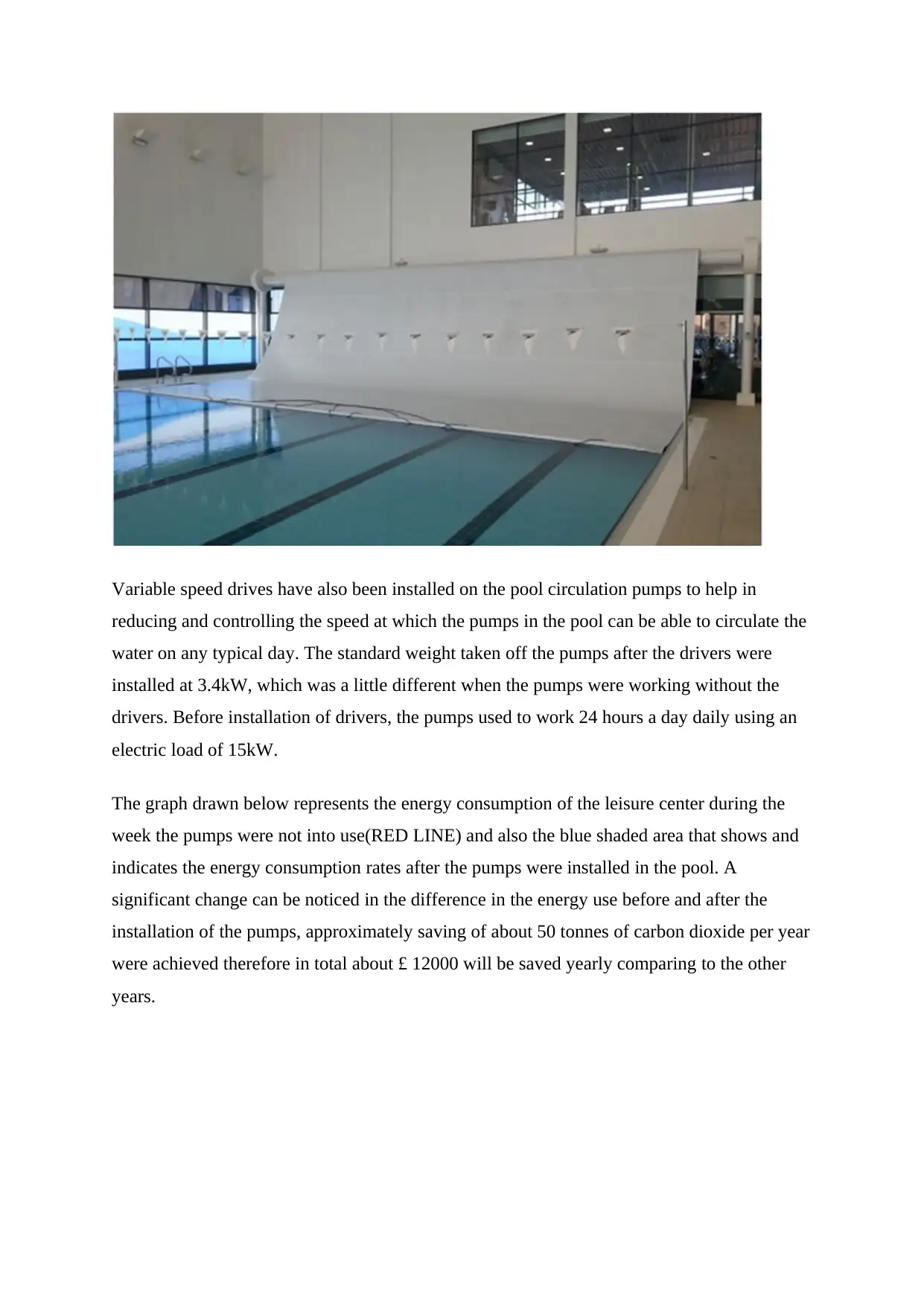
Variable speed drives have also been installed on the pool circulation pumps to help in
reducing and controlling the speed at which the pumps in the pool can be able to circulate the
water on any typical day. The standard weight taken off the pumps after the drivers were
installed at 3.4kW, which was a little different when the pumps were working without the
drivers. Before installation of drivers, the pumps used to work 24 hours a day daily using an
electric load of 15kW.
The graph drawn below represents the energy consumption of the leisure center during the
week the pumps were not into use(RED LINE) and also the blue shaded area that shows and
indicates the energy consumption rates after the pumps were installed in the pool. A
significant change can be noticed in the difference in the energy use before and after the
installation of the pumps, approximately saving of about 50 tonnes of carbon dioxide per year
were achieved therefore in total about £ 12000 will be saved yearly comparing to the other
years.
reducing and controlling the speed at which the pumps in the pool can be able to circulate the
water on any typical day. The standard weight taken off the pumps after the drivers were
installed at 3.4kW, which was a little different when the pumps were working without the
drivers. Before installation of drivers, the pumps used to work 24 hours a day daily using an
electric load of 15kW.
The graph drawn below represents the energy consumption of the leisure center during the
week the pumps were not into use(RED LINE) and also the blue shaded area that shows and
indicates the energy consumption rates after the pumps were installed in the pool. A
significant change can be noticed in the difference in the energy use before and after the
installation of the pumps, approximately saving of about 50 tonnes of carbon dioxide per year
were achieved therefore in total about £ 12000 will be saved yearly comparing to the other
years.
⊘ This is a preview!⊘
Do you want full access?
Subscribe today to unlock all pages.

Trusted by 1+ million students worldwide
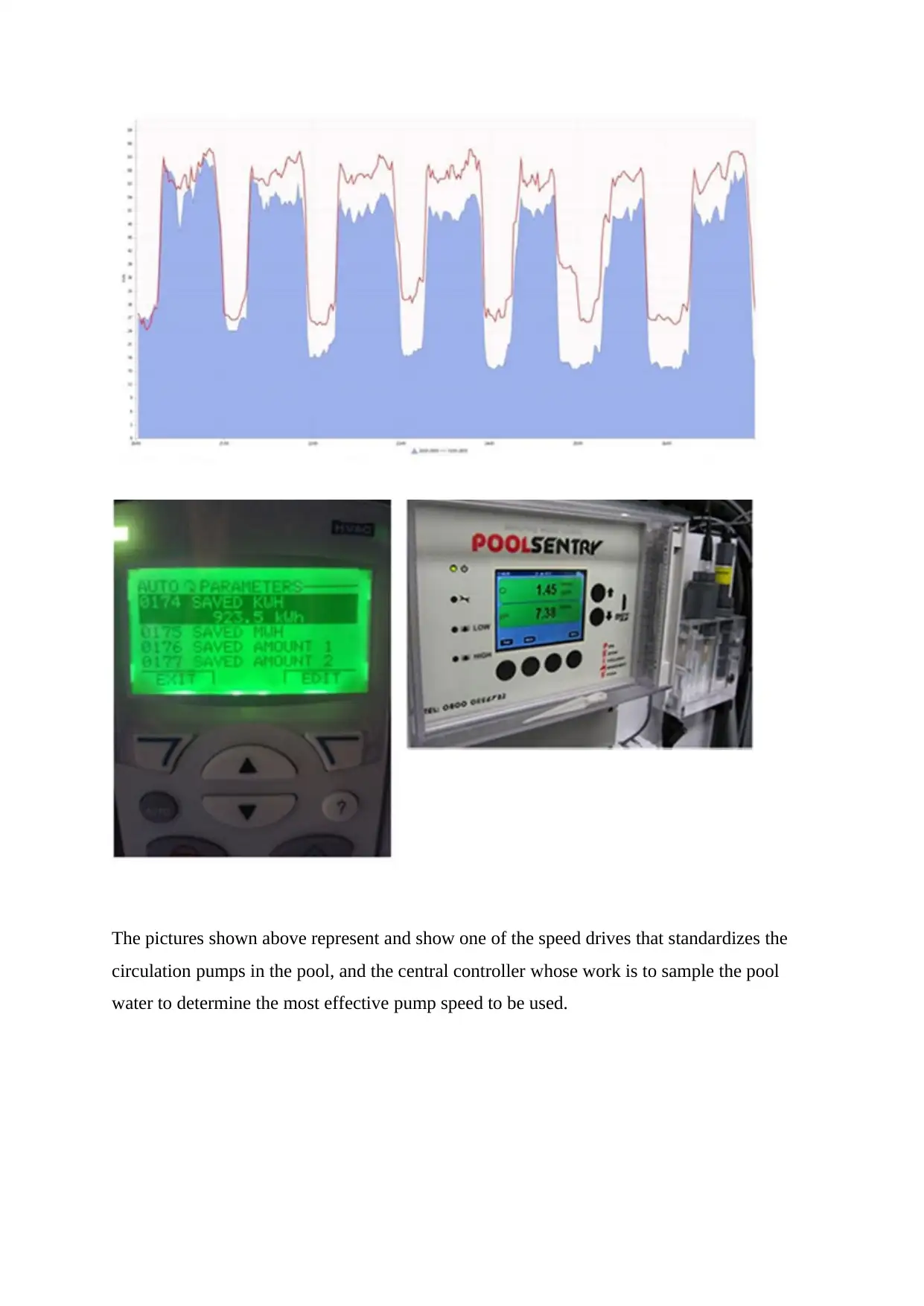
The pictures shown above represent and show one of the speed drives that standardizes the
circulation pumps in the pool, and the central controller whose work is to sample the pool
water to determine the most effective pump speed to be used.
circulation pumps in the pool, and the central controller whose work is to sample the pool
water to determine the most effective pump speed to be used.
Paraphrase This Document
Need a fresh take? Get an instant paraphrase of this document with our AI Paraphraser
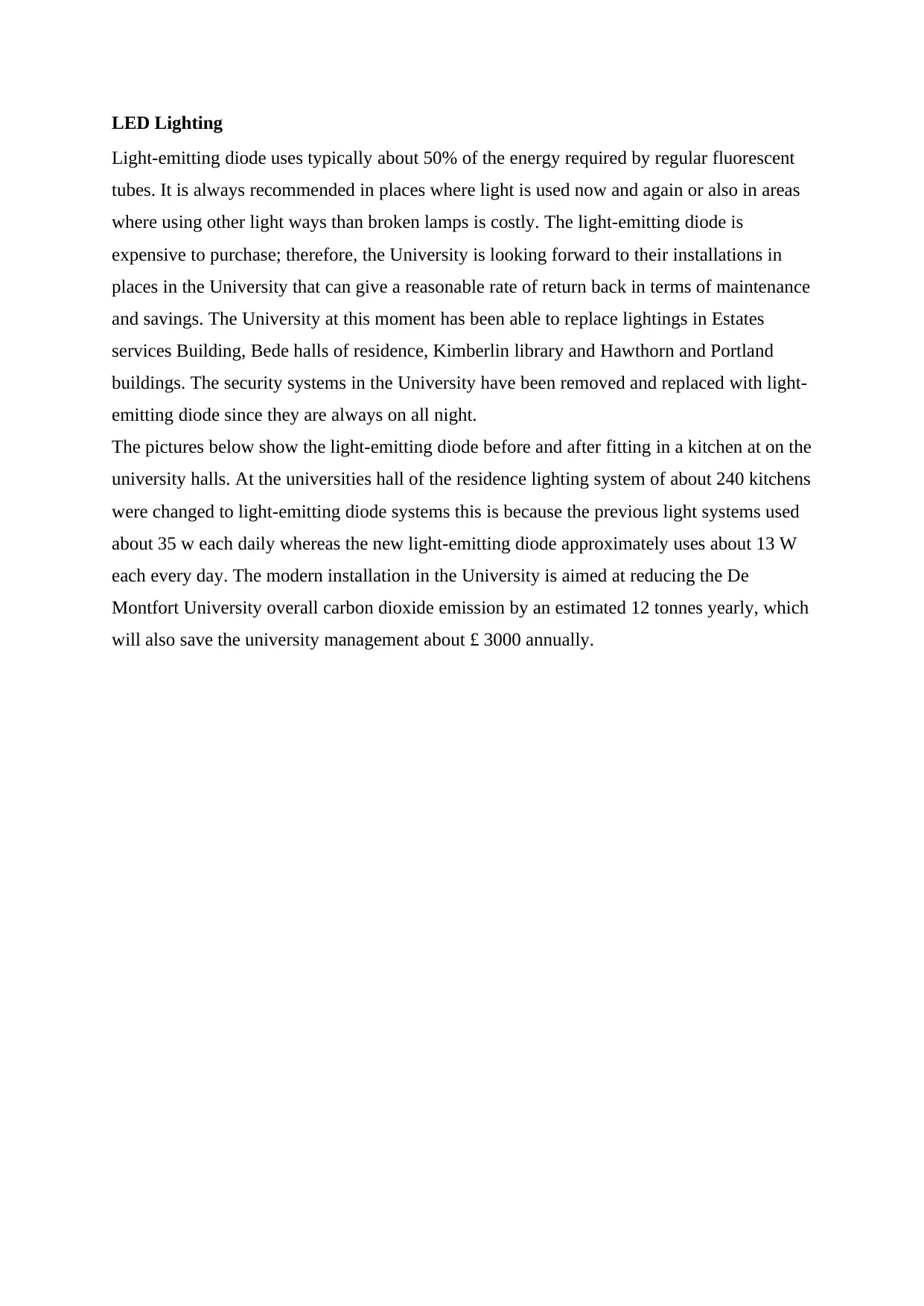
LED Lighting
Light-emitting diode uses typically about 50% of the energy required by regular fluorescent
tubes. It is always recommended in places where light is used now and again or also in areas
where using other light ways than broken lamps is costly. The light-emitting diode is
expensive to purchase; therefore, the University is looking forward to their installations in
places in the University that can give a reasonable rate of return back in terms of maintenance
and savings. The University at this moment has been able to replace lightings in Estates
services Building, Bede halls of residence, Kimberlin library and Hawthorn and Portland
buildings. The security systems in the University have been removed and replaced with light-
emitting diode since they are always on all night.
The pictures below show the light-emitting diode before and after fitting in a kitchen at on the
university halls. At the universities hall of the residence lighting system of about 240 kitchens
were changed to light-emitting diode systems this is because the previous light systems used
about 35 w each daily whereas the new light-emitting diode approximately uses about 13 W
each every day. The modern installation in the University is aimed at reducing the De
Montfort University overall carbon dioxide emission by an estimated 12 tonnes yearly, which
will also save the university management about £ 3000 annually.
Light-emitting diode uses typically about 50% of the energy required by regular fluorescent
tubes. It is always recommended in places where light is used now and again or also in areas
where using other light ways than broken lamps is costly. The light-emitting diode is
expensive to purchase; therefore, the University is looking forward to their installations in
places in the University that can give a reasonable rate of return back in terms of maintenance
and savings. The University at this moment has been able to replace lightings in Estates
services Building, Bede halls of residence, Kimberlin library and Hawthorn and Portland
buildings. The security systems in the University have been removed and replaced with light-
emitting diode since they are always on all night.
The pictures below show the light-emitting diode before and after fitting in a kitchen at on the
university halls. At the universities hall of the residence lighting system of about 240 kitchens
were changed to light-emitting diode systems this is because the previous light systems used
about 35 w each daily whereas the new light-emitting diode approximately uses about 13 W
each every day. The modern installation in the University is aimed at reducing the De
Montfort University overall carbon dioxide emission by an estimated 12 tonnes yearly, which
will also save the university management about £ 3000 annually.
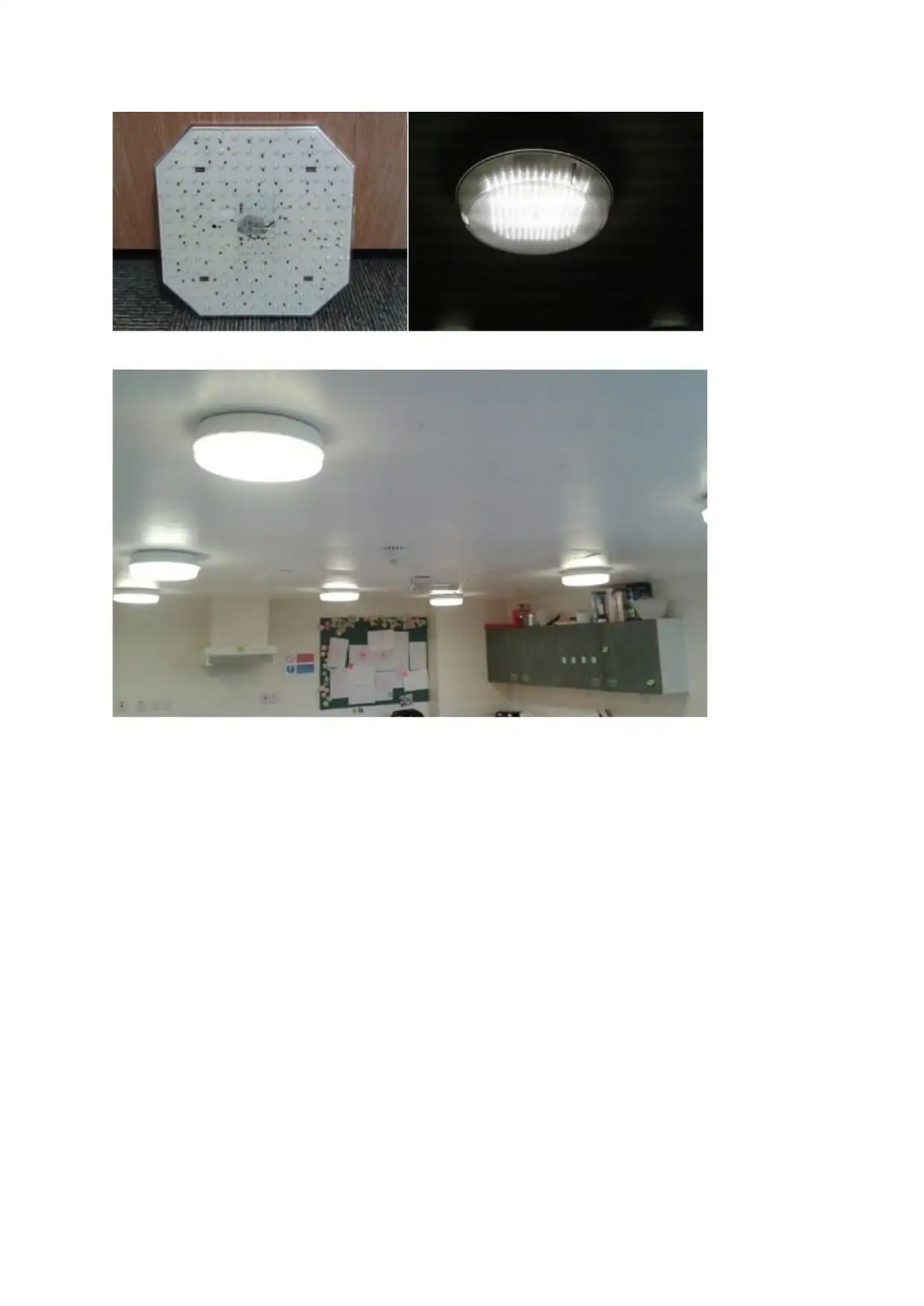
⊘ This is a preview!⊘
Do you want full access?
Subscribe today to unlock all pages.

Trusted by 1+ million students worldwide
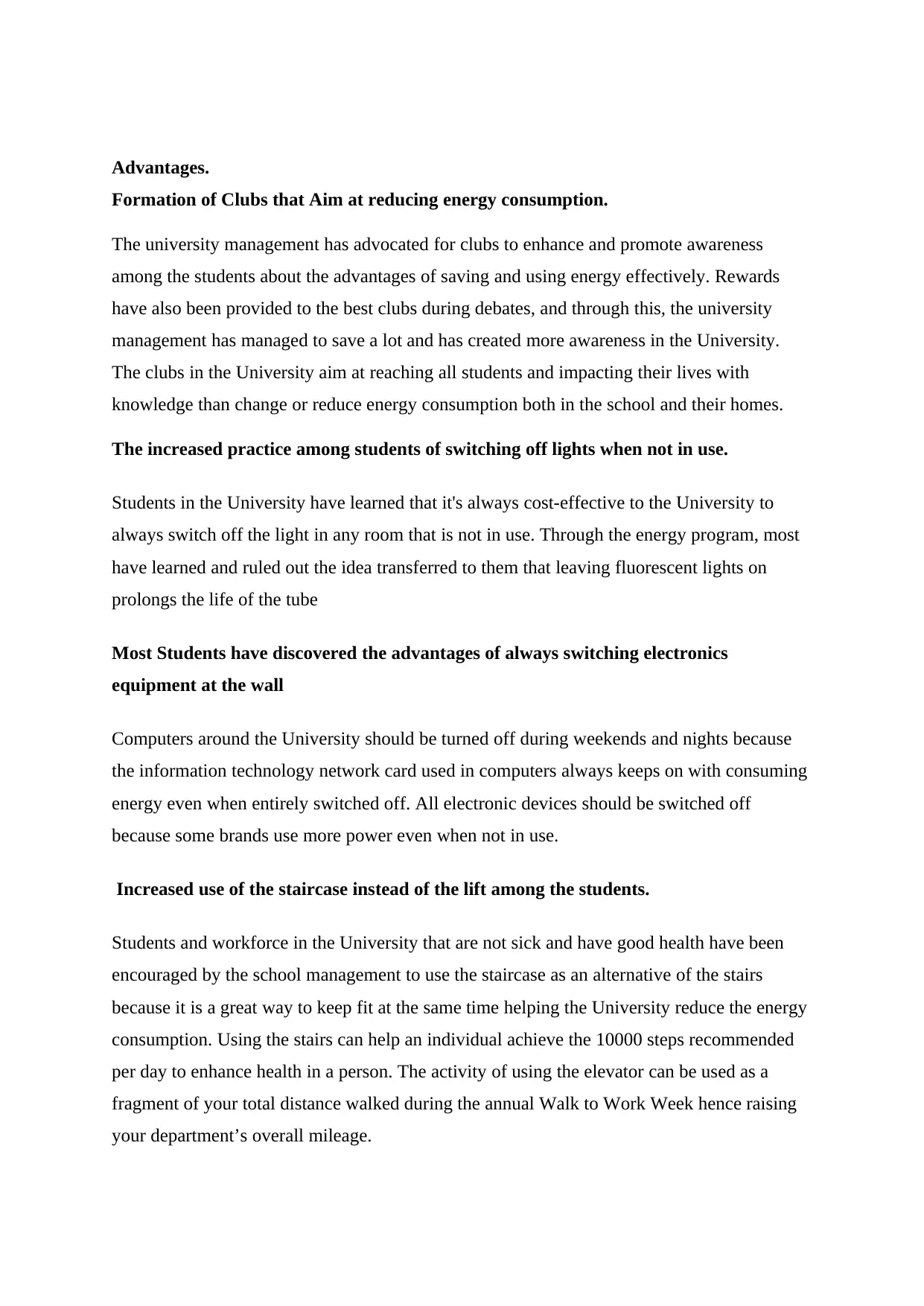
Advantages.
Formation of Clubs that Aim at reducing energy consumption.
The university management has advocated for clubs to enhance and promote awareness
among the students about the advantages of saving and using energy effectively. Rewards
have also been provided to the best clubs during debates, and through this, the university
management has managed to save a lot and has created more awareness in the University.
The clubs in the University aim at reaching all students and impacting their lives with
knowledge than change or reduce energy consumption both in the school and their homes.
The increased practice among students of switching off lights when not in use.
Students in the University have learned that it's always cost-effective to the University to
always switch off the light in any room that is not in use. Through the energy program, most
have learned and ruled out the idea transferred to them that leaving fluorescent lights on
prolongs the life of the tube
Most Students have discovered the advantages of always switching electronics
equipment at the wall
Computers around the University should be turned off during weekends and nights because
the information technology network card used in computers always keeps on with consuming
energy even when entirely switched off. All electronic devices should be switched off
because some brands use more power even when not in use.
Increased use of the staircase instead of the lift among the students.
Students and workforce in the University that are not sick and have good health have been
encouraged by the school management to use the staircase as an alternative of the stairs
because it is a great way to keep fit at the same time helping the University reduce the energy
consumption. Using the stairs can help an individual achieve the 10000 steps recommended
per day to enhance health in a person. The activity of using the elevator can be used as a
fragment of your total distance walked during the annual Walk to Work Week hence raising
your department’s overall mileage.
Formation of Clubs that Aim at reducing energy consumption.
The university management has advocated for clubs to enhance and promote awareness
among the students about the advantages of saving and using energy effectively. Rewards
have also been provided to the best clubs during debates, and through this, the university
management has managed to save a lot and has created more awareness in the University.
The clubs in the University aim at reaching all students and impacting their lives with
knowledge than change or reduce energy consumption both in the school and their homes.
The increased practice among students of switching off lights when not in use.
Students in the University have learned that it's always cost-effective to the University to
always switch off the light in any room that is not in use. Through the energy program, most
have learned and ruled out the idea transferred to them that leaving fluorescent lights on
prolongs the life of the tube
Most Students have discovered the advantages of always switching electronics
equipment at the wall
Computers around the University should be turned off during weekends and nights because
the information technology network card used in computers always keeps on with consuming
energy even when entirely switched off. All electronic devices should be switched off
because some brands use more power even when not in use.
Increased use of the staircase instead of the lift among the students.
Students and workforce in the University that are not sick and have good health have been
encouraged by the school management to use the staircase as an alternative of the stairs
because it is a great way to keep fit at the same time helping the University reduce the energy
consumption. Using the stairs can help an individual achieve the 10000 steps recommended
per day to enhance health in a person. The activity of using the elevator can be used as a
fragment of your total distance walked during the annual Walk to Work Week hence raising
your department’s overall mileage.
Paraphrase This Document
Need a fresh take? Get an instant paraphrase of this document with our AI Paraphraser
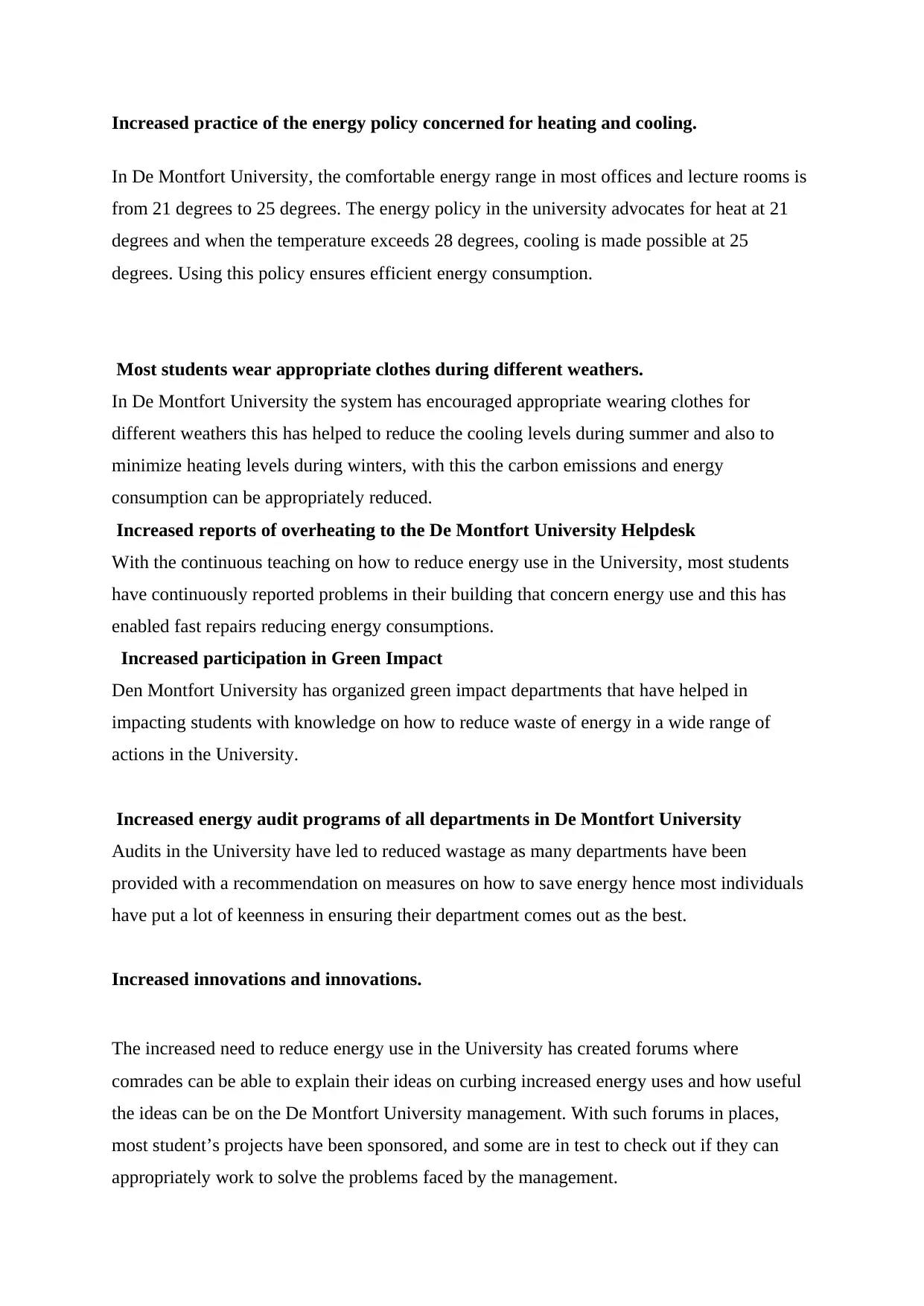
Increased practice of the energy policy concerned for heating and cooling.
In De Montfort University, the comfortable energy range in most offices and lecture rooms is
from 21 degrees to 25 degrees. The energy policy in the university advocates for heat at 21
degrees and when the temperature exceeds 28 degrees, cooling is made possible at 25
degrees. Using this policy ensures efficient energy consumption.
Most students wear appropriate clothes during different weathers.
In De Montfort University the system has encouraged appropriate wearing clothes for
different weathers this has helped to reduce the cooling levels during summer and also to
minimize heating levels during winters, with this the carbon emissions and energy
consumption can be appropriately reduced.
Increased reports of overheating to the De Montfort University Helpdesk
With the continuous teaching on how to reduce energy use in the University, most students
have continuously reported problems in their building that concern energy use and this has
enabled fast repairs reducing energy consumptions.
Increased participation in Green Impact
Den Montfort University has organized green impact departments that have helped in
impacting students with knowledge on how to reduce waste of energy in a wide range of
actions in the University.
Increased energy audit programs of all departments in De Montfort University
Audits in the University have led to reduced wastage as many departments have been
provided with a recommendation on measures on how to save energy hence most individuals
have put a lot of keenness in ensuring their department comes out as the best.
Increased innovations and innovations.
The increased need to reduce energy use in the University has created forums where
comrades can be able to explain their ideas on curbing increased energy uses and how useful
the ideas can be on the De Montfort University management. With such forums in places,
most student’s projects have been sponsored, and some are in test to check out if they can
appropriately work to solve the problems faced by the management.
In De Montfort University, the comfortable energy range in most offices and lecture rooms is
from 21 degrees to 25 degrees. The energy policy in the university advocates for heat at 21
degrees and when the temperature exceeds 28 degrees, cooling is made possible at 25
degrees. Using this policy ensures efficient energy consumption.
Most students wear appropriate clothes during different weathers.
In De Montfort University the system has encouraged appropriate wearing clothes for
different weathers this has helped to reduce the cooling levels during summer and also to
minimize heating levels during winters, with this the carbon emissions and energy
consumption can be appropriately reduced.
Increased reports of overheating to the De Montfort University Helpdesk
With the continuous teaching on how to reduce energy use in the University, most students
have continuously reported problems in their building that concern energy use and this has
enabled fast repairs reducing energy consumptions.
Increased participation in Green Impact
Den Montfort University has organized green impact departments that have helped in
impacting students with knowledge on how to reduce waste of energy in a wide range of
actions in the University.
Increased energy audit programs of all departments in De Montfort University
Audits in the University have led to reduced wastage as many departments have been
provided with a recommendation on measures on how to save energy hence most individuals
have put a lot of keenness in ensuring their department comes out as the best.
Increased innovations and innovations.
The increased need to reduce energy use in the University has created forums where
comrades can be able to explain their ideas on curbing increased energy uses and how useful
the ideas can be on the De Montfort University management. With such forums in places,
most student’s projects have been sponsored, and some are in test to check out if they can
appropriately work to solve the problems faced by the management.
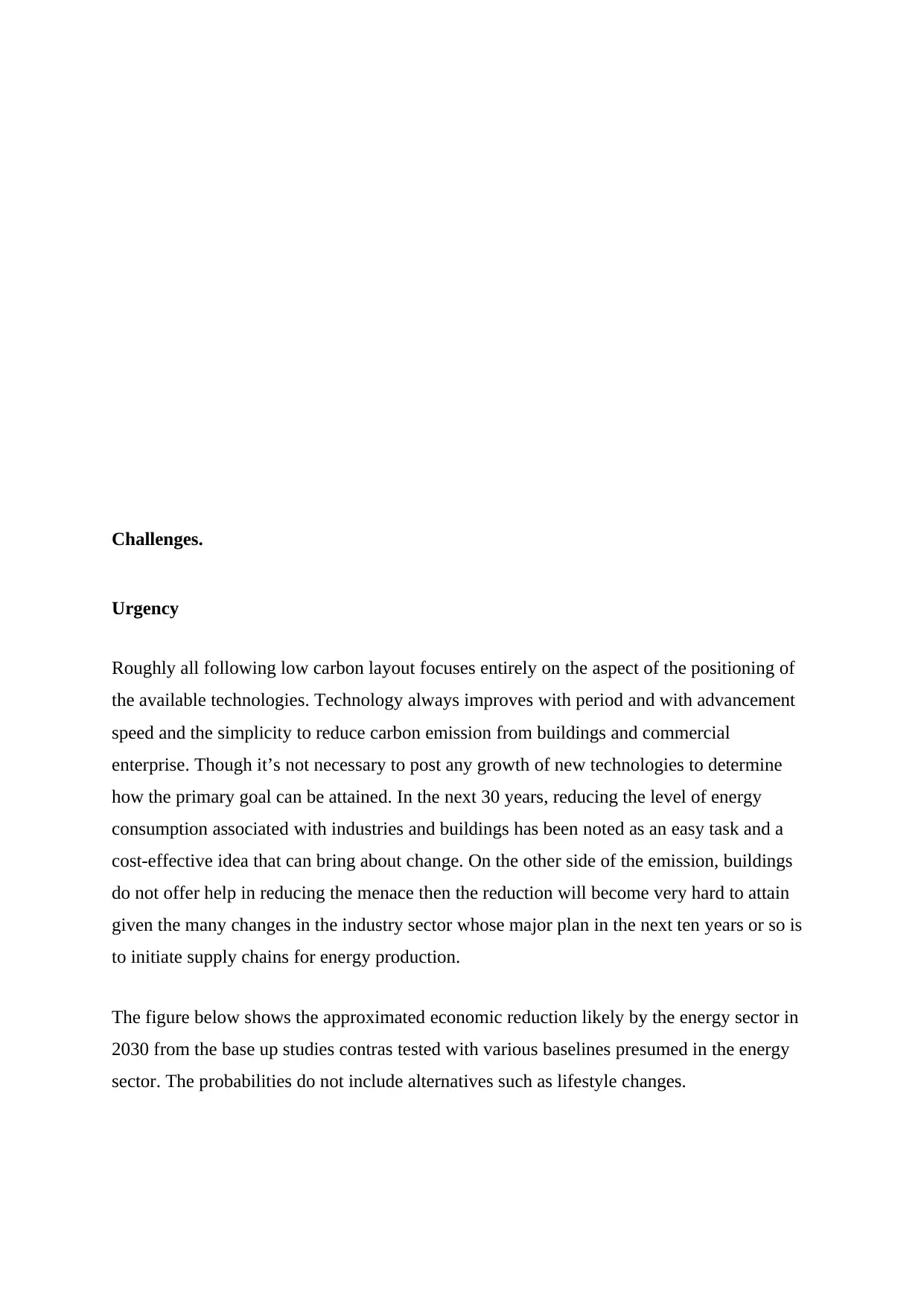
Challenges.
Urgency
Roughly all following low carbon layout focuses entirely on the aspect of the positioning of
the available technologies. Technology always improves with period and with advancement
speed and the simplicity to reduce carbon emission from buildings and commercial
enterprise. Though it’s not necessary to post any growth of new technologies to determine
how the primary goal can be attained. In the next 30 years, reducing the level of energy
consumption associated with industries and buildings has been noted as an easy task and a
cost-effective idea that can bring about change. On the other side of the emission, buildings
do not offer help in reducing the menace then the reduction will become very hard to attain
given the many changes in the industry sector whose major plan in the next ten years or so is
to initiate supply chains for energy production.
The figure below shows the approximated economic reduction likely by the energy sector in
2030 from the base up studies contras tested with various baselines presumed in the energy
sector. The probabilities do not include alternatives such as lifestyle changes.
Urgency
Roughly all following low carbon layout focuses entirely on the aspect of the positioning of
the available technologies. Technology always improves with period and with advancement
speed and the simplicity to reduce carbon emission from buildings and commercial
enterprise. Though it’s not necessary to post any growth of new technologies to determine
how the primary goal can be attained. In the next 30 years, reducing the level of energy
consumption associated with industries and buildings has been noted as an easy task and a
cost-effective idea that can bring about change. On the other side of the emission, buildings
do not offer help in reducing the menace then the reduction will become very hard to attain
given the many changes in the industry sector whose major plan in the next ten years or so is
to initiate supply chains for energy production.
The figure below shows the approximated economic reduction likely by the energy sector in
2030 from the base up studies contras tested with various baselines presumed in the energy
sector. The probabilities do not include alternatives such as lifestyle changes.
⊘ This is a preview!⊘
Do you want full access?
Subscribe today to unlock all pages.

Trusted by 1+ million students worldwide
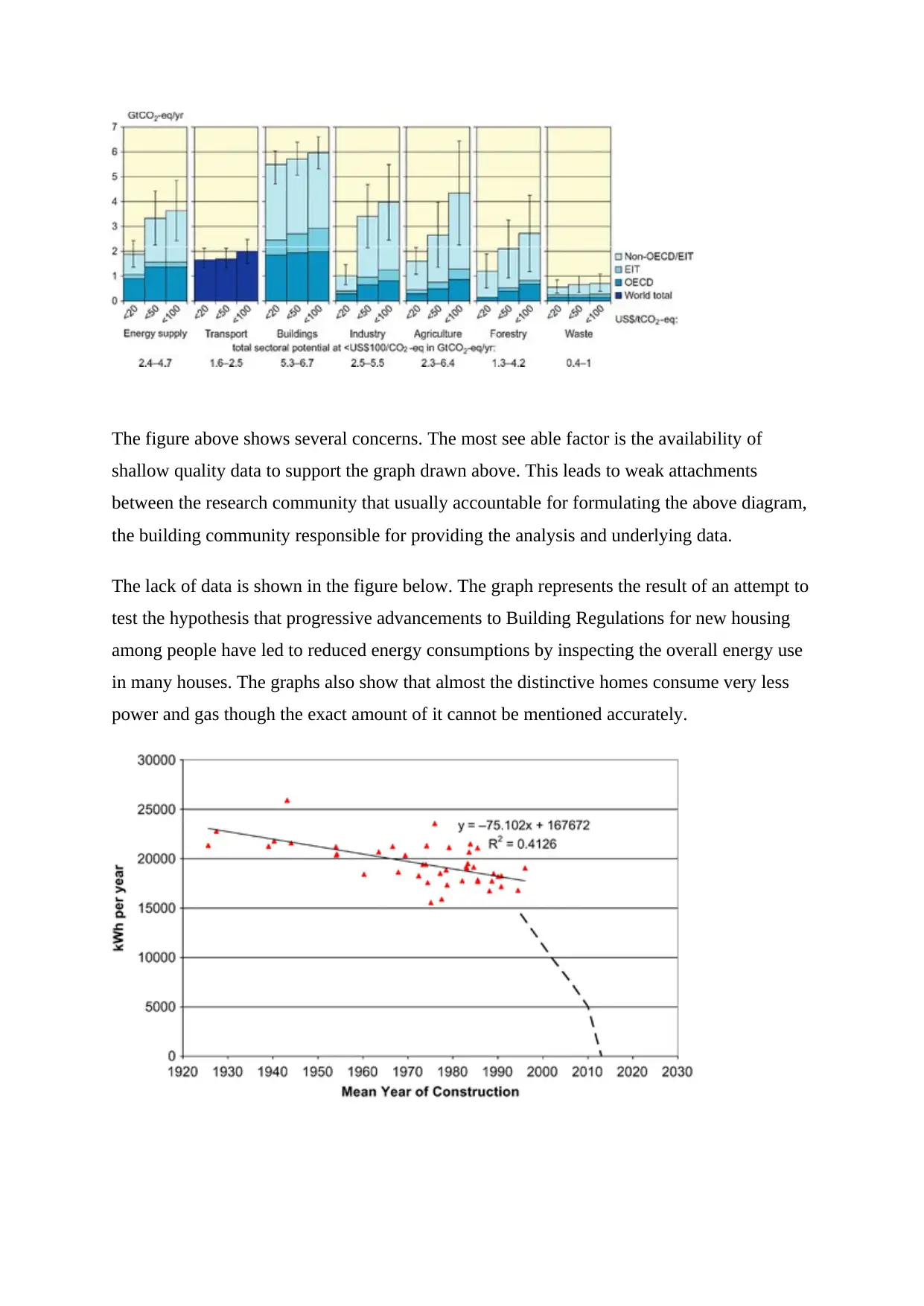
The figure above shows several concerns. The most see able factor is the availability of
shallow quality data to support the graph drawn above. This leads to weak attachments
between the research community that usually accountable for formulating the above diagram,
the building community responsible for providing the analysis and underlying data.
The lack of data is shown in the figure below. The graph represents the result of an attempt to
test the hypothesis that progressive advancements to Building Regulations for new housing
among people have led to reduced energy consumptions by inspecting the overall energy use
in many houses. The graphs also show that almost the distinctive homes consume very less
power and gas though the exact amount of it cannot be mentioned accurately.
shallow quality data to support the graph drawn above. This leads to weak attachments
between the research community that usually accountable for formulating the above diagram,
the building community responsible for providing the analysis and underlying data.
The lack of data is shown in the figure below. The graph represents the result of an attempt to
test the hypothesis that progressive advancements to Building Regulations for new housing
among people have led to reduced energy consumptions by inspecting the overall energy use
in many houses. The graphs also show that almost the distinctive homes consume very less
power and gas though the exact amount of it cannot be mentioned accurately.
Paraphrase This Document
Need a fresh take? Get an instant paraphrase of this document with our AI Paraphraser
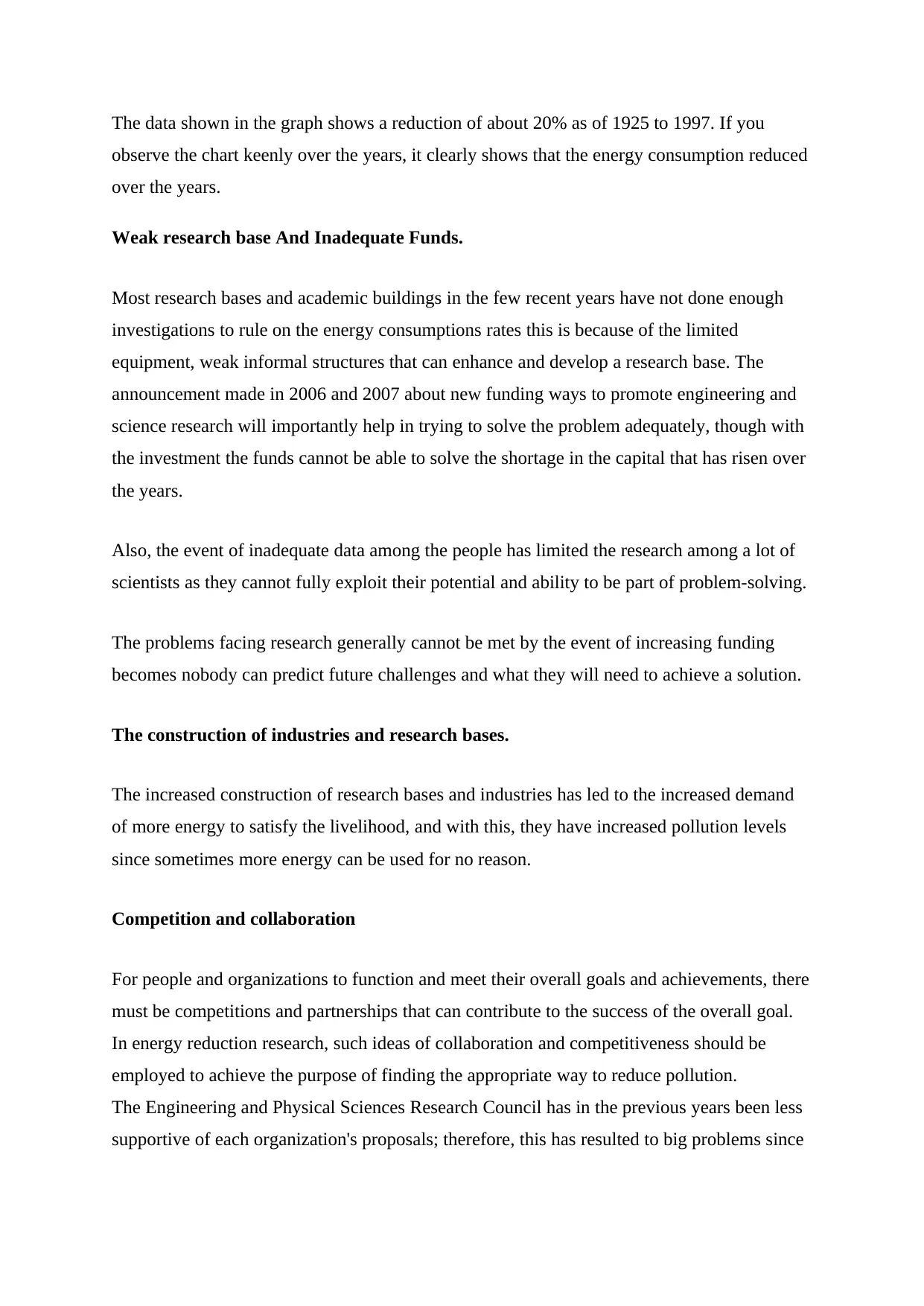
The data shown in the graph shows a reduction of about 20% as of 1925 to 1997. If you
observe the chart keenly over the years, it clearly shows that the energy consumption reduced
over the years.
Weak research base And Inadequate Funds.
Most research bases and academic buildings in the few recent years have not done enough
investigations to rule on the energy consumptions rates this is because of the limited
equipment, weak informal structures that can enhance and develop a research base. The
announcement made in 2006 and 2007 about new funding ways to promote engineering and
science research will importantly help in trying to solve the problem adequately, though with
the investment the funds cannot be able to solve the shortage in the capital that has risen over
the years.
Also, the event of inadequate data among the people has limited the research among a lot of
scientists as they cannot fully exploit their potential and ability to be part of problem-solving.
The problems facing research generally cannot be met by the event of increasing funding
becomes nobody can predict future challenges and what they will need to achieve a solution.
The construction of industries and research bases.
The increased construction of research bases and industries has led to the increased demand
of more energy to satisfy the livelihood, and with this, they have increased pollution levels
since sometimes more energy can be used for no reason.
Competition and collaboration
For people and organizations to function and meet their overall goals and achievements, there
must be competitions and partnerships that can contribute to the success of the overall goal.
In energy reduction research, such ideas of collaboration and competitiveness should be
employed to achieve the purpose of finding the appropriate way to reduce pollution.
The Engineering and Physical Sciences Research Council has in the previous years been less
supportive of each organization's proposals; therefore, this has resulted to big problems since
observe the chart keenly over the years, it clearly shows that the energy consumption reduced
over the years.
Weak research base And Inadequate Funds.
Most research bases and academic buildings in the few recent years have not done enough
investigations to rule on the energy consumptions rates this is because of the limited
equipment, weak informal structures that can enhance and develop a research base. The
announcement made in 2006 and 2007 about new funding ways to promote engineering and
science research will importantly help in trying to solve the problem adequately, though with
the investment the funds cannot be able to solve the shortage in the capital that has risen over
the years.
Also, the event of inadequate data among the people has limited the research among a lot of
scientists as they cannot fully exploit their potential and ability to be part of problem-solving.
The problems facing research generally cannot be met by the event of increasing funding
becomes nobody can predict future challenges and what they will need to achieve a solution.
The construction of industries and research bases.
The increased construction of research bases and industries has led to the increased demand
of more energy to satisfy the livelihood, and with this, they have increased pollution levels
since sometimes more energy can be used for no reason.
Competition and collaboration
For people and organizations to function and meet their overall goals and achievements, there
must be competitions and partnerships that can contribute to the success of the overall goal.
In energy reduction research, such ideas of collaboration and competitiveness should be
employed to achieve the purpose of finding the appropriate way to reduce pollution.
The Engineering and Physical Sciences Research Council has in the previous years been less
supportive of each organization's proposals; therefore, this has resulted to big problems since
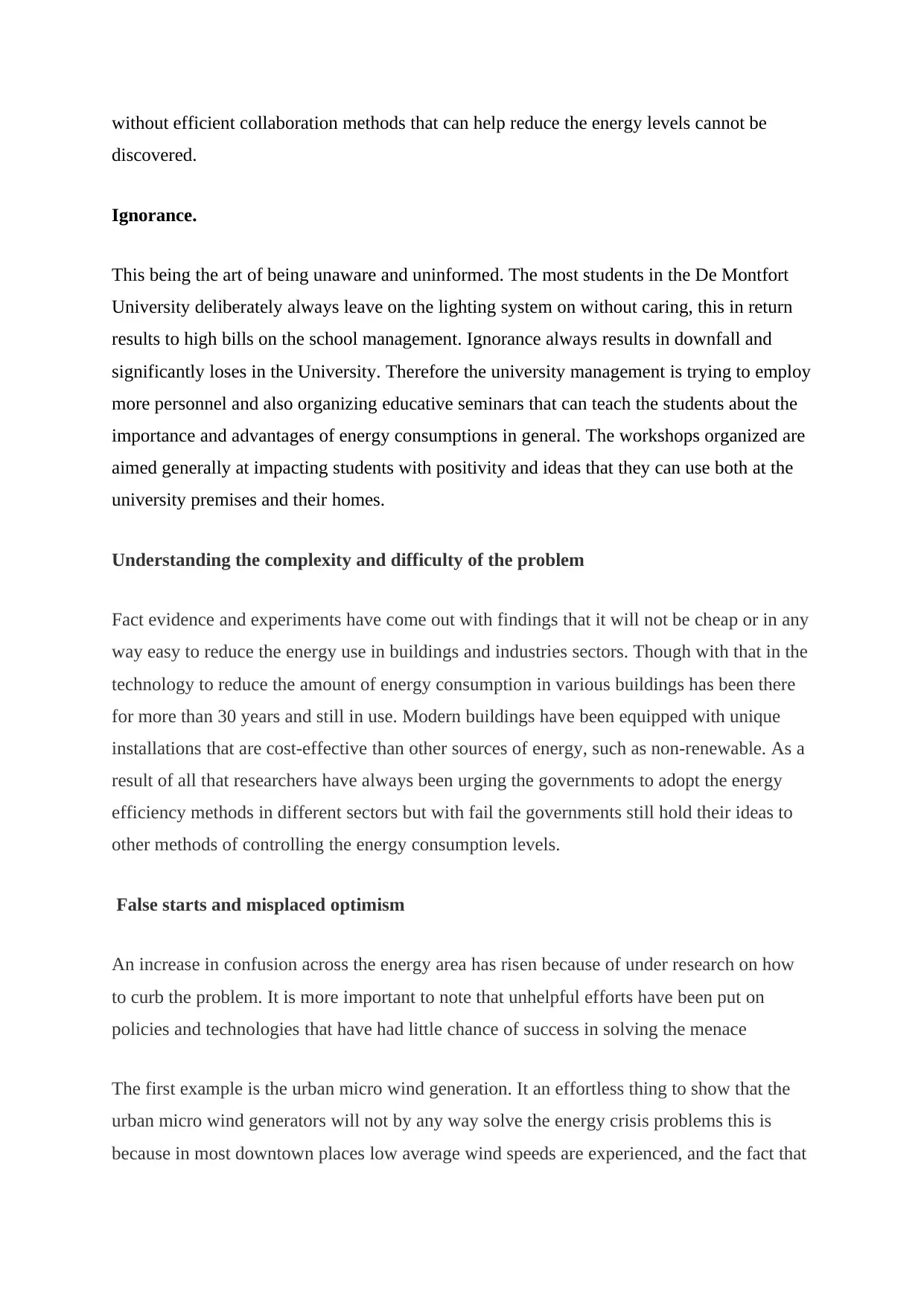
without efficient collaboration methods that can help reduce the energy levels cannot be
discovered.
Ignorance.
This being the art of being unaware and uninformed. The most students in the De Montfort
University deliberately always leave on the lighting system on without caring, this in return
results to high bills on the school management. Ignorance always results in downfall and
significantly loses in the University. Therefore the university management is trying to employ
more personnel and also organizing educative seminars that can teach the students about the
importance and advantages of energy consumptions in general. The workshops organized are
aimed generally at impacting students with positivity and ideas that they can use both at the
university premises and their homes.
Understanding the complexity and difficulty of the problem
Fact evidence and experiments have come out with findings that it will not be cheap or in any
way easy to reduce the energy use in buildings and industries sectors. Though with that in the
technology to reduce the amount of energy consumption in various buildings has been there
for more than 30 years and still in use. Modern buildings have been equipped with unique
installations that are cost-effective than other sources of energy, such as non-renewable. As a
result of all that researchers have always been urging the governments to adopt the energy
efficiency methods in different sectors but with fail the governments still hold their ideas to
other methods of controlling the energy consumption levels.
False starts and misplaced optimism
An increase in confusion across the energy area has risen because of under research on how
to curb the problem. It is more important to note that unhelpful efforts have been put on
policies and technologies that have had little chance of success in solving the menace
The first example is the urban micro wind generation. It an effortless thing to show that the
urban micro wind generators will not by any way solve the energy crisis problems this is
because in most downtown places low average wind speeds are experienced, and the fact that
discovered.
Ignorance.
This being the art of being unaware and uninformed. The most students in the De Montfort
University deliberately always leave on the lighting system on without caring, this in return
results to high bills on the school management. Ignorance always results in downfall and
significantly loses in the University. Therefore the university management is trying to employ
more personnel and also organizing educative seminars that can teach the students about the
importance and advantages of energy consumptions in general. The workshops organized are
aimed generally at impacting students with positivity and ideas that they can use both at the
university premises and their homes.
Understanding the complexity and difficulty of the problem
Fact evidence and experiments have come out with findings that it will not be cheap or in any
way easy to reduce the energy use in buildings and industries sectors. Though with that in the
technology to reduce the amount of energy consumption in various buildings has been there
for more than 30 years and still in use. Modern buildings have been equipped with unique
installations that are cost-effective than other sources of energy, such as non-renewable. As a
result of all that researchers have always been urging the governments to adopt the energy
efficiency methods in different sectors but with fail the governments still hold their ideas to
other methods of controlling the energy consumption levels.
False starts and misplaced optimism
An increase in confusion across the energy area has risen because of under research on how
to curb the problem. It is more important to note that unhelpful efforts have been put on
policies and technologies that have had little chance of success in solving the menace
The first example is the urban micro wind generation. It an effortless thing to show that the
urban micro wind generators will not by any way solve the energy crisis problems this is
because in most downtown places low average wind speeds are experienced, and the fact that
⊘ This is a preview!⊘
Do you want full access?
Subscribe today to unlock all pages.

Trusted by 1+ million students worldwide
1 out of 16
Your All-in-One AI-Powered Toolkit for Academic Success.
+13062052269
info@desklib.com
Available 24*7 on WhatsApp / Email
![[object Object]](/_next/static/media/star-bottom.7253800d.svg)
Unlock your academic potential
Copyright © 2020–2025 A2Z Services. All Rights Reserved. Developed and managed by ZUCOL.